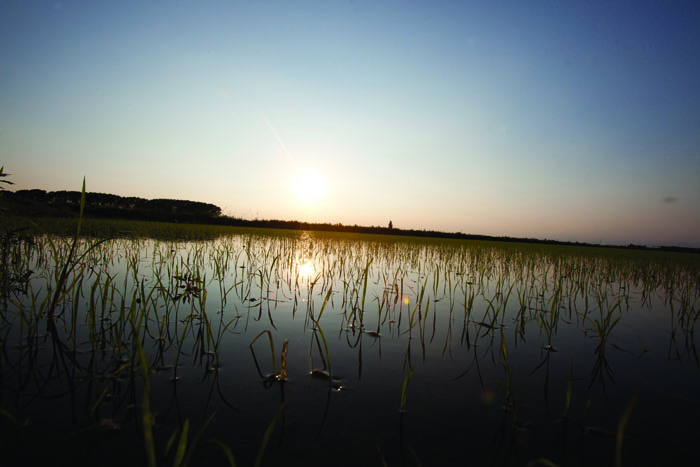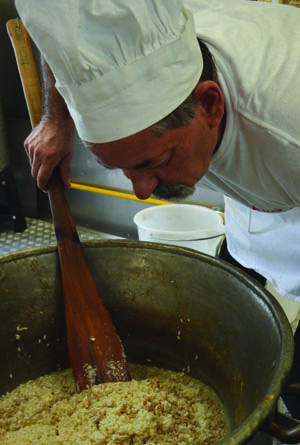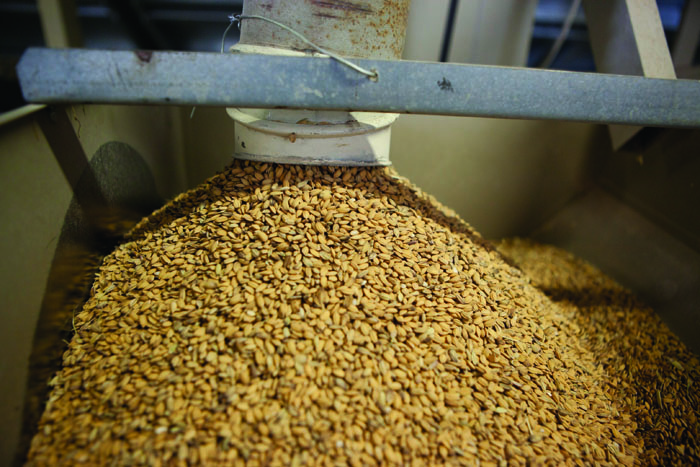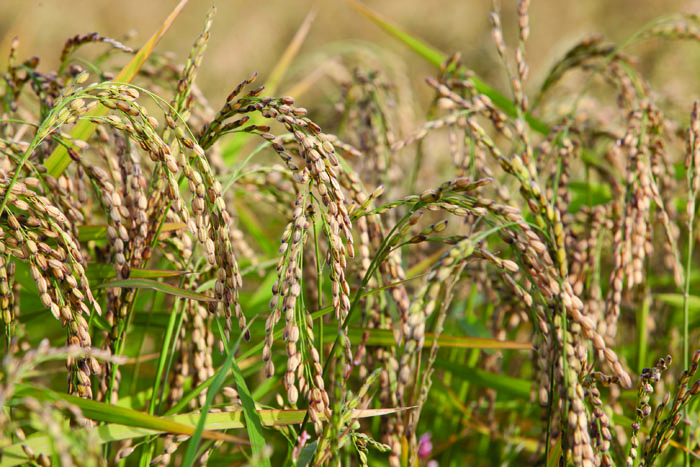It is, sadly, a dying industry, with cheap imports threatening to change this landscape forever. But Kevin Pilley finds that in Italy there is still devotion to the humble grain of rice, and, of course, to the risotto it makes…

Italy’s first, and so far only, official rice ambassador looked solemnly down at my plate, shook his head mournfully and delivered his judgment: “This is not risotto. It is sludge. Mush.”
“Glop,” I admitted.
“Value her. She is like a precious pearl,” said the Maestro di Cucina, holding up a tiny grain to the sunlight. “She is in the heart of every Italian.”
Rice is in Gabriele Ferron’s every thinking moment. He grows and mills his own rice on his Pila Vecchia Antica Riseria family farm in the paddy fields of the Padana Valley, 20 miles south of Verona and an hour and a half west of Venice. The family farm goes back to 1650. Ferron owns a collection of ancient rice-harvesting equipment. The farm is a living museum to a rural way of life that is now under threat.
“It’s still great to prepare and eat risotto rice.”
His smiled turned into a fatalistic shrug. “But no longer to grow it.”

Big Business
After the Far East and the Indian subcontinent, the United States and Brazil, Italy remains one of the world’s largest rice producers, and certainly the largest in Europe. The Italian rice industry seasonally employs some 6,000 farmers and 60 rice millers. The industry produces 1.4 million tonnes of rice every year and has an annual turnover of over €1 billion. The country’s ancient rice fields cover approximately 240,000 hectares and stretch over the provinces of Vercelli, Pavia, Novara, Milano, Ferrara, Oristano, Mantova and Verona. Of all the rice eaten in Europe, more than 60 per cent has been produced in Italy.
 But the profession is suffering as farmers turn to more commercial alternatives. Or give up entirely in the face of free trade. Due to imported rice from the United States and Thailand, the Haitian and Honduran rice industries have already virtually collapsed. The Po Valley and plains of Verona may follow. Along with the Ferrons, only five other families now work the ancient paddy fields around the Isola della Scala – La Città del Riso – the self-proclaimed rice capital of Italy… And of Europe. Domestic consumption is in danger of being swamped by cheaper imports. Quality cannot compete with quantity. Global warming is not helping either: The Bassa Veronese wetlands are slowly drying up.
But the profession is suffering as farmers turn to more commercial alternatives. Or give up entirely in the face of free trade. Due to imported rice from the United States and Thailand, the Haitian and Honduran rice industries have already virtually collapsed. The Po Valley and plains of Verona may follow. Along with the Ferrons, only five other families now work the ancient paddy fields around the Isola della Scala – La Città del Riso – the self-proclaimed rice capital of Italy… And of Europe. Domestic consumption is in danger of being swamped by cheaper imports. Quality cannot compete with quantity. Global warming is not helping either: The Bassa Veronese wetlands are slowly drying up.
In Ferron’s Restaurant Torre (he is an acclaimed chef as well as an official rice ambassador) the grissini are made from rice flour, as is all the pasta. Ferron makes rice tiramisù as well as rice ice cream. Cheese is served with rice jam.
And he is not alone. Virtually every restaurant in town is a rissoteria offering rice degustazioni. Restaurants serve special set menus offering courgette flower risotto and risottos with oranges, red chicory and Gorgonzola and spinach. And Ferron gives risotto masterclasses in typical Italian manner.
“There are different types of rice, like there are different types of women. Blonde and brunette. Plump like Arborio or short like Nano. Some with perfect bodies. Some with real souls! You must treat a risotto like a woman. Woo her. Spoil her. Lavish time on her. And she will repay you!”
The Festival of Risotto
At the region’s annual month-long autumn Risotto Festival, La Festa del Risotto, more than 300,000 plates of risotto are consumed. At its fair, La Fiera del Riso, you will find on sale everything you can imagine that can be made from rice, from rice biscuits and wafers (gallette) to rice espresso, rice grappa, rice beer and even rice facial cream and shampoo.
The festival in Isola della Scala (formerly Isola Cenense – “the muddy land”) began in 1967 restoring the tradition of working feasts at the end of the summer harvest. Local chefs and farmers meet to discuss and judge their produce and compete for prestigious prizes like Il Chicco d’Oro – the Golden Grain – and La Spiga d’Oro – The Golden Ear.
“They are the Oscars of the Italian rice world!” says Isola commune spokesperson Alberto Cogo. “Isola is the Hollywood of the rice growing world!”
Isola is the beginning and end of the La Strada del Riso Vialone Nano Veronese, or “Rice Road”, which takes in 22 villages like Buttapietra, Palu and Nogara.

The Melotti Family
The Melotti family is another local rice dynasty. Says Giuseppe Melotti, “Recipes have been handed down through generations. The traditional local one uses sirloin, veal, rosemary and cinnamon. This land was reclaimed by the Etruscans and cultivated by the Romans. Rice is part of our history. Rossini’s opera Tancredi has a ‘rice aria’! But the landscape is changing, physically and economically. Until the 1960s, 200,000 female mondine worked the rice fields around Verona. The children of rice workers had their own school. Rice field workers invented their own folk music.”
Travelling the Rice Road is a history lesson. While the Romans used rice seeds as medicine, rice was probably properly introduced into mainland Italy during the late Middle Ages by Venetian or Genoese merchants. The Arabs brought seeds into Sicily, but northern Italy – despite the risk of malaria – was perfect for its cultivation, with its high temperatures and large quantities of water. Irrigation and water distribution systems were developed. The flooding of the rice fields is a centuries-old ritual, though scientists have found that the water contains high levels of toxic herbicide. In 1839 a Dominican friar brought disease-resistant seeds from the Philippines…
Italy’s rice farmers grow short, barrel-shaped rice rather than long grain. There are four categories based on grain size: comune, semifino, fino, and superfino, the type most used for risotto.

Risotto alla Milanese is arguably the most famous Italian rice dish, flavoured with saffron and resembling Spanish paella. (Milan was under Spanish rule for nearly two centuries.) In Piedmont it is not unusual to find risotto with truffles. In the city of Venice, sautéed eel risotto is a Christmas tradition.
The risotto dish, being similar to pilaf, may have been a Venetian invention, or it may have come via southern Italy from the Saracens. In 1574, while working on Verona’s cathedral, the master glassworker, who used saffron to colour his paints, is said to have added saffron to a rice dish served at a wedding. The guest pronounced it risus optimus (excellent rice) later possibly shortened to risotto.
My private lesson came to an end. The master demonstrated. And became chauvinistic. The rice undulated under his gyrating spatula. “She must be brought to the boil allegro. Cared for and looked after at all times. Repeatedly toasted with fine wine.”
He adopted a learned, scholarly expression, and winked. “She must be constantly tasted. Her flesh must be firm and succulent and never lumpy.”
It was clearly his stock line.
Getting There:
➤ The Isola della Scala is a rural comune to the south of Verona. You can get to Verona by aeroplane, but then you will need alternative transport to take you down the SS12. A car would do the job perfectly adequately, but you could also go by bicycle. The rice will thank you for it too. www.veronagarda
bike.com
